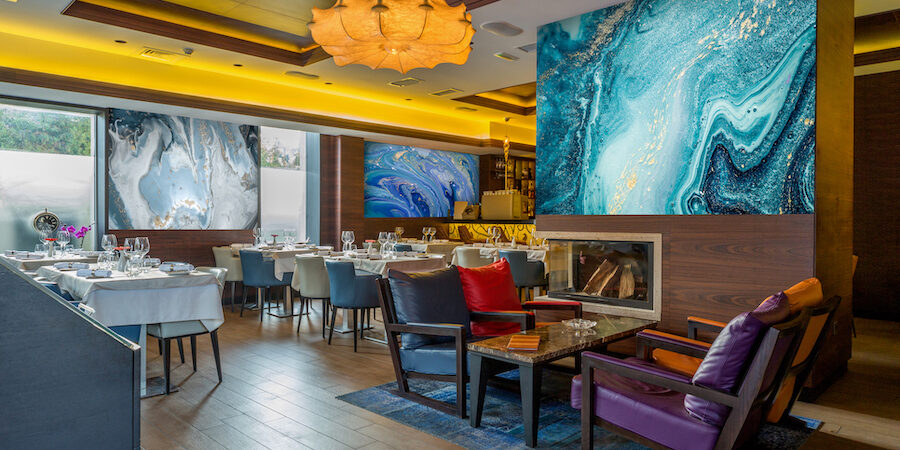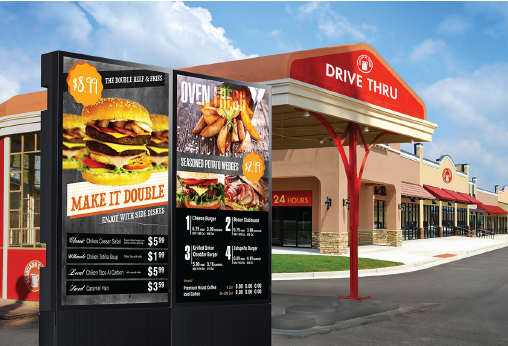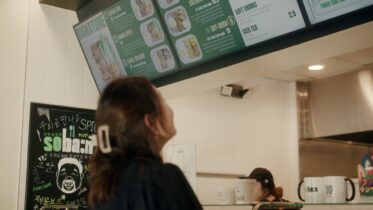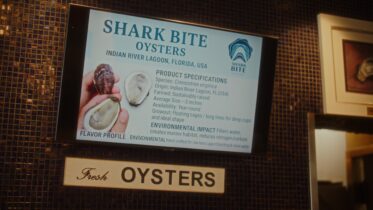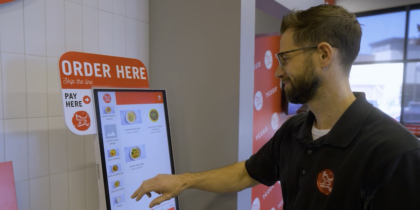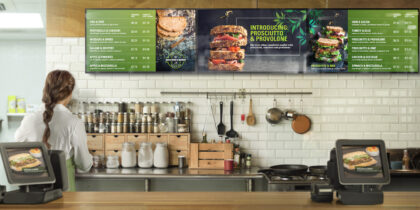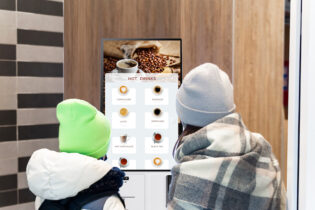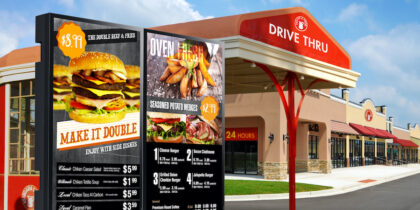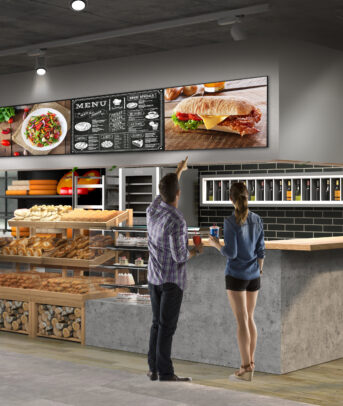Outdoor and indoor digital displays provide a powerful tool for restaurants and quick service restaurants (QSRs) to market their business and improve the customer experience. While using signage to draw in customers is nothing new, today’s digital displays can do so much more to enhance the brand image, guide the customer, and boost profits. Whether it be targeting messages to specific parts of the day, capturing data on customer behavior to inform business strategy, or simply speeding the transaction process, displays can save everyone time and money.
However, while dynamic digital displays play a key role in attracting and enticing customers to sites, they must be kept fresh and up-to-date to reap the benefits of digital signage in restaurants. That means changing display content, for example, to highlight daily specials, promotional deals and even charitable opportunities for consumers. Or you could adjust traffic directionals to lessen waiting times inside at the counter or outside at the drive-thru. This will keep customers engaged and coming back for more. Here’s how else they can help.
Attract more customers
Modern outdoor LED signage helps to spotlight QSRs and drive traffic to their establishments, often appealing to hungry consumers and prompting an impulse stop. This is key, as research shows spending by Americans on impulse purchases is growing. Further, introducing new digital displays can boost restaurant and QSR sales, according to the Sign Research Foundation, which said that adding one sign at every fast-food outlet in Los Angeles, for example, would increase total business revenues by $132 million.
Pole-mounted LED signage, such as Samsung XPR-B series, is ideal for showcasing menu specials and seasonal promotions in high detail, as well as greeting customers entering the restaurant. Window displays can also promote new products and time-of-day offers to increase basket size.
Improve the customer experience
Dual-sided displays offer a double benefit by enabling QSRs to present unique content inside and outside on their own schedules. Digital signage can welcome customers to the restaurant, list opening hours, showcase updated menus, highlight daily specials and promote community events and charitable opportunities. Similarly, displays can be changed in response to ambient conditions. When the weather gets cold, for example, digital signage can display offers for hot cocoa — and vice versa on a hot day, promoting cold drinks and ice cream.
All of these options — and many more — enable QSRs to speak more directly to customers and satisfy their needs at any given moment. Not only that, when used smartly, digital signage makes the customer experience smoother and easier, getting them to their meal faster and with fewer obstacles. That’s something customers will remember for next time.
Enhance brand management
From an operational perspective, digital displays enable restaurants to remotely access and manage their campaigns, see what’s playing on-screen and change the content when required, thanks to a flexible and intuitive restaurant content management system (CMS). With a seamless CMS like Samsung VXT , operators can strengthen their brand and ensure it stands out from the crowd. This helps create a distinct brand identity that will be more memorable for guests and thereby inspire return visits. Furthermore, because brand messaging can be updated across the entire display ecosystem — be it one location or many — QSRs can be assured of maintaining a consistent brand image.
Modernize your quick service restaurant with displays
Explore how digital signage is improving customer experiences and motivating QSR employees. Download Now
Displays integrated with partner solutions like GRUBBRR, which powers Samsung self-service kiosks, can achieve even more. For example, they can help QSRs seamlessly deliver loyalty programs and redemption offers to customers, as well as personalized messages, recommendations based on purchase history and dietary preferences, relevant coupons at any given location, and even birthday wishes. That personalization further enhances the brand to the customer, making them more loyal and responsive and driving a long-term return on investment for the business.
Elevate functionality
Customers increasingly expect frictionless digital experiences. They are used to using and interacting with technology in other aspects of their lives such as shopping, banking and travel. As a result, they expect similar experiences in restaurants across multiple touchpoints. Deloitte, for instance, found that 58% of consumers prefer to order digitally at a QSR versus a cashier. Given this appetite for digital interactions, restaurants need to ensure their displays are fresh, eye-catching and engaging. They need to create immersive dining experiences from the moment their guests arrive.
In-store digital menu boards, such as Samsung UHD Signage, help operators deliver a more interactive and engaging customer experience, especially when combined with a high-quality CMS, which ensures displays are always up-to-date. This combination also helps keep displays functioning as they should and increases their durability and reliability.
Strategies to keep displays fresh
Restaurants and QSRs should maximize the opportunity to refresh content on displays regularly. One strategy is to use a campaign calendar to schedule fresh content on both a daily and weekly basis. For example, if you offer a football Sunday special or a kids-eat-free deal on Friday, you can schedule these ahead of time and ensure the language and images make an impact.
Teams can also plan seasonal activities based on annual events and holidays, including school graduations, festivals and Thanksgiving. They might also look ahead to upcoming weather conditions and create offers to match. This might dovetail with inventory and ingredient cycles, promoting certain menu items when the volume is high to both drive orders and reduce waste. Another idea to keep displays fresh could be to preview upcoming changes to the menu, be it a seasonal switch or a new dish, increasing interest and recognition before it even becomes available.
Value that grows over time
Digital displays, such as digital menu boards, tick multiple boxes. Coupled with a content management system, they give restaurants and QSRs complete ownership and control of their brand messaging, and the vibrant imagery and language attract more customers and help ensure their experience is positive and memorable. Over time, this increases return on investment, especially compared to restaurants and QSRs that don’t make the most of digital signage or pass the many benefits to the customer.
Sign up for a VXT free trial here. To help make your digital signage solution as effective as possible, learn more about digital signage use cases in the quick service restaurant industry with this free guide.
